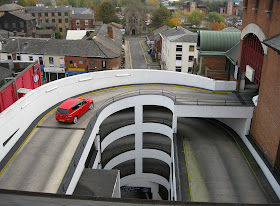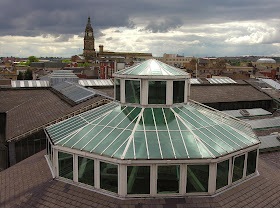And below those, a picture I took myself from the same rooftop, a few years ago.


My own:

-----
By the way, tip about photoshop: under Image/Adjustments/, it has a "black and white" option, which lets you adjust how light or dark each color should be when converted. Sort of like putting a color filter on your lens when shooting in BW, only more flexible. You can make a blue sky very dark, or make greenery much lighter, and such things. In the picture above, I lightened Red, which made red bricks less heavy, and lightened up the red car.
If you google around for tutorials you'll find there are many sophisticated ways to convert colour -> BW. Some of them offer far better conversions that simple default BW conversion, or even than manual colour channel belnds. I think there used to be a good tutorial on LuminousLandscape if I recall. I've also played with adding film grain to BW conversions as this can introduce a feeling of old film BW shots. There are some PS filters that combine conversion and film effects. I tried one really good one once but unfortunately I could tell you offhand which one it was now. You would probably be best off experimenting and exploring various methods before plunking down hundreds of dollars for one. These automated filters have a tendency to look good at first and quickly become disused after your tastes change. Having been through that cycle a couple times I'm really loath to blow cash on such temporary satisfactions now.
ReplyDeletePlease excuse my typos. I really wish there was an edit button here.
ReplyDeleteRegarding your recent post about digital B+W. I think that you can get excellent B+W from digital and mostly it is dependent on this conversion process and the eye deciding that conversion.
ReplyDeleteThanks for the tips, Eolake and Chris !
ReplyDeleteYou seem to leaning toward exploring digital B&W which I have found can be fun and aggravating at the same time. I prefer to do my conversions in ACR or Lightroom 2. Much more room to maneuver when using a 16 bit file. The Luminosity and Contrast sliders are large step in the right direction. If you are not using CS4 with the latest version of ACR I would suggest investing it Lightroom. The workflow is smooth and it seems to treat the files a bit better.
ReplyDeleteOne book I would suggest reading is B&W Printing by George DeWolfe, although I do not know if it economically available in the UK. A clean and to the point tutorial that covers most of the topics. My best.
Thanks, I'll look at the book.
ReplyDeleteI dunno, I'm rather schizophrenic about color and BW, I tend to go back and forth.
I think I could have fun with a BW digital camera, one without the Bayer color filter on the sensor. Not only should the sensor's sensitivity improve, but it would also be a different experience to think in BW from start to end.
I tend to go back and forth with B&W myself. Some pictures are just better in B&W, others in color.
ReplyDeleteAs a starting to having a monochrome camera try setting one of your DSLRs to shot raw and ljpg. Set the camera to B&W and maybe a red filter. When you look at the LCD for post exposure review the image will be B&W. You can see how it looks in B&W and if worthy of conversion of the raw file. It will help you to start seeing in B&W.
I set my G9 this way and when using ISO 400 it has almost a film like grain.